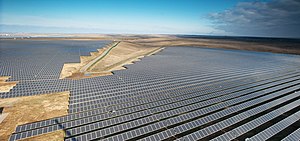Energy in Ukraine is mainly from gas and nuclear, followed by oil and coal.[1] Ukraine has a diversified energy mix, and no fuel takes up more than a third of the country’s energy sources. The coal industry has been disrupted by conflict.[2] Most gas and oil is imported, but since 2015 energy policy has prioritised diversifying energy supply.[1]

About half of electricity generation is nuclear and a quarter coal.[1] The largest nuclear power plant in Europe, the Zaporizhzhia Nuclear Power Plant, is located in Ukraine. Fossil fuel subsidies were USD 1.6 billion in 2021.[3] Until the 2010s all of Ukraine's nuclear fuel came from Russia, but now most does not.[4]
Ukraine’s gas network has a lot of storage, which can be useful for storing Europe’s gas to even out supply and demand,[5] and it formerly transited a lot of Russian natural gas to Europe but that agreement ends at the end of 2024.[6] Some energy infrastructure was destroyed in the Russo-Ukrainian War,[7][8] but wind farms and solar power are thought to be resilient because they are distributed.[9] An energy strategy to 2050 was adopted in 2023 but has not yet been published.[10]

Gas
Ukraine has been estimated to possess natural gas reserves of over 670 billions cubic meters (in 2022),[11] and in 2018 was ranked 26th among countries with proved reserves of natural gas.[12] Its total gas reserves have been estimated at 1.870 trillion cubic meters.[13] In 2021, Ukraine produced 19.8 billion cubic meters (bcm or Gm3) of natural gas. To satisfy domestic demand of 27.3 bcm that year, Ukraine relied on gas imports (2.6 bcm) and withdrawal from underground storage (4.9 bcm). Winter demand can reach 150 mcm per day.[14]
During Soviet times, Ukraine produced a record of 68.7 bcm in 1976. At the time of independence in 1991, production was at 26.6 bcm, and fell in the 1990s to about 18 bcm. Since the mid-2000s, production has stabilised between 20 and 21 bcm.[15] According to a report issued by the OECD, over 70% of domestic gas production is extracted by UkrGasVydobuvannya,[16] a subsidiary of the state-owned company Naftogaz. Private gas production companies in Ukraine are DTEK Oil&Gas, Ukrnaftoburinnya, Burisma, Smart Energy, Poltava Petroleum Company, Geo Alliance Group, and KUB-GAS.[17]
Ukraine stopped buying gas from Russia in November 2015 to reduce gas dependence after the outbreak of the Russo-Ukrainian war,[18] but instead buys it indirectly from traders in Western Europe as part of the Russian gas that transits through Ukraine.[14] The contract to transit Russian gas expires at the end of 2024.[19]Coal

Coal mining has historically been an important industry in Ukraine.[20][21] Coal mining in Ukraine is often associated with coal-rich Donets basin. However this is not the only coal mining region, other being Lviv-Volhynian basin and Dnieper brown coal mining basin. The Donets basin located in the eastern Ukraine is the most developed and much bigger coal mining region in the country.
Ukraine was until recently, the third largest coal producer in Europe.[22] In 1976, national production was 218 million metric tonnes. By 2016, production had dropped to 41 million metric tonnes. The Donets Black Coal Basin in the eastern Ukraine, with 90% of the nation's reserves, suffers from three connected problems: (1) mines are not profitable enough to sustain capital investment, resulting in twenty-year-old mining equipment and processes, (2) the government, taking advice from the International Monetary Fund, has discontinued $600 million annual mining subsidies, and (3) the Ukrainian government refuses to buy from mines controlled by the self-proclaimed Donetsk People's Republic and Luhansk People's Republic.Electricity


The electricity sector in Ukraine is an important part of energy in Ukraine. Electricity production fell from 296 TWh in 1991 to 171 TWh in 1999, then increased slowly to 195 TWh in 2007, before falling again.[23]
In 2011, Ukraine joined the European Energy Community, however there has been slow progress on implementing European energy regulations.[24]
On 1 July 2019, a new wholesale energy market was launched, intended to bring real competition in the generation market and help future integration with Europe. The change was a prerequisite for receiving European Union assistance. It led to in increased price for industrial consumers of between 14% and 28% during July. The bulk of Energoatom output is sold to the government's "guaranteed buyer" to keep prices more stable for domestic customers.[24][25]
Most electricity generation is nuclear.[26] The largest nuclear power plant in Europe, the Zaporizhzhia Nuclear Power Plant, is located in Ukraine. Until the 2010s all of Ukraine's nuclear fuel came from Russia, but now most does not.[27] Some electricity infrastructure was destroyed in the Russo-Ukrainian War,[28][29] but wind farms and solar power are thought to be resilient because they are distributed.[30] As of 2024 about 1,700 MW can be imported from other European countries and it is hoped to increase this to cover peak demand.[26]Renewable energy

Finance
Ukraine signed a loan agreement in-principle for $3.65 billion with the China Development Bank in 2012, during President Viktor Yanukovich's term of office, contingent on the development of agreed projects in the coal and gas sectors. However, by 2017 Ukraine had not agreed any suitable projects due to a "lack of convergence in the positions of [Uglesintezgaz] and the energy ministry".[35] Elementum Energy Ltd owns the most power plants.[36]
During war

In the winter of 2022-23 Russia targeted switchyards and transformers, but the following year they concentrated on power plants perhaps because they are harder to protect and take longer to repair.[9]
See also
- 2022 Russia–European Union gas dispute – Fossil fuel financing-related conflicts
- Rotterdam Plus – Steam coal pricing methodology
References
External links


